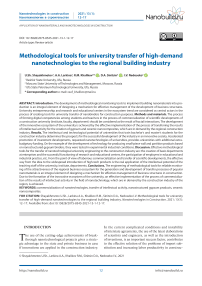Methodological tools for university transfer of high-demand nanotechnologies to the regional building industry
Автор: Shayakhmetov U.Sh., Larkina A.A., Khalikov R.M., Sinitsin D.A., Nedoseko I.V.
Журнал: Nanotechnologies in Construction: A Scientific Internet-Journal @nanobuild-en
Рубрика: Application of nanomaterials and nanotechnologies in construction
Статья в выпуске: 1 Vol.13, 2021 года.
Бесплатный доступ
Introduction. The development of methodological monitoring tools to implement building nanomaterials into production is an integral element of designing a mechanism for effective management of the development of business structures. University entrepreneurship and research and educational centers in the ecosystem trend are considered as central actors in the process of creating tools for university transfer of nanobinders for construction purposes. Methods and materials. The process of forming digital competencies among students and teachers in the process of commercialization of scientific developments of a construction university (institute, faculty, department) should be considered as the result of fractal interactions. The development of the innovative ecosystem of the university is achieved by the effective implementation of the process of transferring the results of intellectual activity for the creation of gypsum and ceramic nanocomposites, which are in demand by the regional construction industry. Results. The intellectual and technological potential of universities that train bachelor’s and master’s students for the construction industry determines the prospects for the successful development of the industry in an innovative society. Accelerated promotion of investment developments, requested nanotechnologies of universities, provides universities with additional extrabudgetary funding. On the example of the development of technology for producing small-piece wall and partition products based on nanostructured gypsum binders, they were tested in experimental industrial conditions. Discussion. Effective methodological tools for the transfer of nanotechnological university engineering to the construction industry are: the creation of basic departments at enterprises and the successful functioning of research and educational centers, the participation of employers in educational and industrial practice, etc. From the point of view of laborious commercialization and transfer of scientific developments, the effective way from the idea to the widespread introduction of high-tech products is the real application of the intellectual potential of the teaching staff of the university, institute, departments. Conclusions. The engineering of methodological tools for reliable monitoring of the attractiveness of the regional business ecosystem for the generation and development of transfer processes of popular nanomaterials is an integral element of designing a mechanism for effective management of business structures in construction. Due to the formation of the innovative ecosystem of the university, an effective implementation of the process of commercialization of the results of intellectual activity in the field of nanotechnology, which are in demand by the construction industry of the region, is achieved.
Commercialization of nanotechnologies, transfer of intellectual activity, nanostructured gypsum products, ceramic nanocomposites
Короткий адрес: https://sciup.org/142226929
IDR: 142226929 | DOI: 10.15828/2075-8545-2021-13-1-12-17
Текст научной статьи Methodological tools for university transfer of high-demand nanotechnologies to the regional building industry
T he use of the cutting-edge achievements of breakthrough nanotechnological projects gives a strategic advantage to the state and private business in case if innovations are applied in the construction industry.
In the current complicated conditions and instability of interstate agreements, the use of the latest elaborations of scientists and engineers, as well as the introduction of inventions, is an important success factor, contributes to the effective solution of the problems of import substitution and increasing labor productivity in construc-
APPLICATION OF NANOMATERIALS AND NANOTECHNOLOGIES IN CONSTRUCTION tion [1]. At the same time, a significant part of the results of research activities of construction universities, as well as required nanotechnology projects, remain unimplemented in practice and do not generate income due to the weak development of organizational and economic transfer mechanisms. In this regard, the search for innovative solutions to increase the efficiency of commercialization of nanotechnology innovations, taking into account the needs of the state and business in the regional construction industry, is still of great importance.
This article is aimed at testing the ecosystem approach in the transfer and commercialization of scientific projects in demand by the building industry of nanotechnology.
MATERIALS AND METHODS
The current challenges the Russian Federation is facing have worsened in the context of the coronavirus pandemic. That is why intensive search for trends in the fullscale modernization of the regional and all-Russian building industry is so urgent and burning. Our state can preserve the “ecological niche” in the accelerated construction of the XXI century only by commercialization and expansion of the entrepreneurial sector of university science: the correlation between the effectiveness of research and development work and the gross domestic product is quite high r = 0.99 [2]. Only an integrated approach to each stage of the transfer: from creating new business ideas and evaluating commercial potential [3] to forecasting the scientific and technical development of industries and implementing the development of technological strategies of construction companies leads to success.
The formation of the infrastructure to support the innovation activities of Russian universities is carried out within a number of organizational forms: science and technology parks, technology commercialization centers, small innovative enterprises, research and educational centers of universities, institutes, etc. Today the formation of a productive transfer, which is a tools for overcoming continuous crisis situations, meets various barriers; at the same time, the strategy of technological breakthrough provides a dynamic start for competitive sectors of the Russian economy. Effective solution of such an urgent task is impossible without the involvement of academic high-tech science, because it is practical transfers that act as points of growth of the construction industry.
The calculated indicator of the specific volume of business entities among small and medium-sized businesses in 2010–2015 indicates that only about 70% are engaged in real activities [4]. This means that in the business environment of the Russian Federation there are diverse and multidirectional factors that restrain the increase in business activity in the construction industry. Many potentially developments will not be identified unless sustainable competitive advantages and opportunities for their transfer in the construction industry are provided.
The key issue of modern nanotechnology in the construction industry is the effective transfer of high-demand development from one market participant to another on a commercial and non-commercial basis. The trend approach, based on the entrepreneurial ecosystem of the construction industry, differs from the cluster approach in that the main subject is an entrepreneur who is able to coordinate efforts and resources, and not a construction company (firm). It should be noted that in the ecosystem trend, entrepreneurship is considered not only as a part of the construction industry, but also as a central actor in the successful functioning of construction organizations and in supporting the transfer of nanotechnological projects.
Within the framework of the system approach [5], the dominant influence is acquired by the environment, where economically active construction companies interact with each other and with the economic sphere. To design effective management systems for the transfer of the results of intellectual activity of universities and the formation of active entrepreneurship at the regional level, it is necessary to take into account fractal interactions in the building industry [6].
RESULTS
The ecosystem approach focuses on the geographical logistics of interconnected construction companies, service providers and related companies, which, while competing with each other, also interact in the format of cooperation and transfer of research activities of construction universities [7]. In the modern conditions
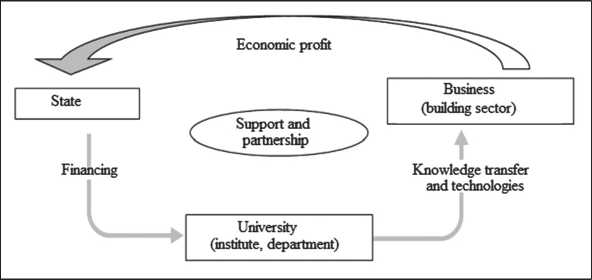
Fig. 1. Interactive and fractal interaction of the state, business and universities in the framework of commercialization of claimed technologies in the building industry
APPLICATION OF NANOMATERIALS AND NANOTECHNOLOGIES IN CONSTRUCTION of transformation of post-industrial society, methodological tools for commercialization and transfer of university nanotechnologies to the construction industry are being formed (Fig. 1).
The development of methodological tools for monitoring the attractiveness of the regional business ecosystem for generating development is an integral element of designing a mechanism for effective management of business development in the building industry. In this context, it is important to assess the state of the ecosystem in terms of its attractiveness for the reproduction
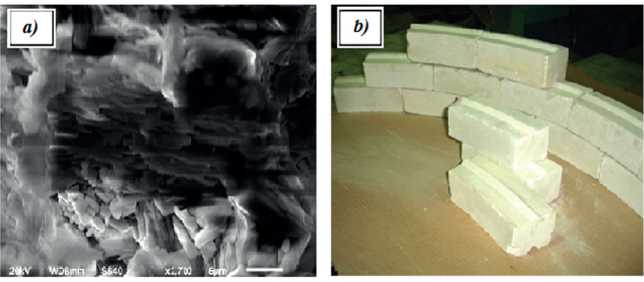
Fig. 2. a – Technological production based on nanostructured gypsum binders; b – pressed partition products
(birth) of new high-tech enterprises in the building industry [8]. The interpretation of the ecosystem of university science and entrepreneurship as an ensemble of social and economic structures in the region that support the growth of innovative start-ups contributes to the emergence of new business structures with a sufficiently high level of risk.
From the point of view of intensive commercialization and transfer of scientific developments, the effective way is the real application of the intellectual potential of the university, construction institute (faculty), departments; competence and experience to attract additional funding, as well as strengthening the functioning of universities as drivers of technological development of the state. For example, the university transfer of high-demand nanotechnologies with the participation of professors of the Ufa State Petroleum Technical University (USNTU) made it possible to implement (Fig. 2) on the basis of nanostructured gypsum binders with a size of ≈ 2 nm–100 nm [9] technologies for producing small-piece wall and partition products, which were tested in experimental industrial conditions [10–12].
Higher professional education should provide training of qualified and mobile specialists for the building industry, ready to independently and effectively solve emerging problems [13]. We have identified the effective conditions for the development of professional competencies of bachelors and undergraduates during their studies at the university: the fractal approach allows lecturers and students to look at trivial things outside the box, to adapt to creative thinking. An important role is played by the commercial component of cooperation between education ↔ science ↔ technology [14] with the strengthening of integration processes within the framework of scientific and educational centers , implemented in the Architectural and Building Institute of USPTU.
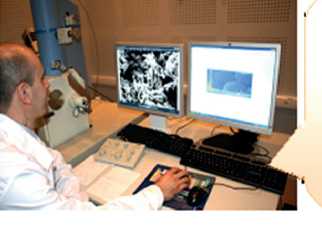
Fig. 3. Scanning electron microscope JEOL JSM-6610LV with the energy dispersive spectrometer Oxford Inca Energy
In the innovation center (“Laboratory of Nanotechnologies of Cement Systems named after Professors A.F. Polak and N.H. Karimov”) of the Architectural and Construction Institute of USNTU, leading specialists of the department, as well as bachelors, undergraduates, postgraduates, doctoral students in the field of development of building materials, research of their nanostructure and technological properties are conducting highly-demanded researches. The scanning electron microscope JEOL JSM-6610LV is actively used for microanalysis of nanomaterials at the Department “Building Structures” of USNTU (Fig. 3); to perform X-ray diffraction and phase analysis – X-ray diffractometer D2 PHASER.
DISCUSSION
Each region, including the Republic of Bashkortostan, has its own unique structure of the regional ecosystem of construction entrepreneurship, and its effectiveness in terms of generating development is determined by the quality of interactive interaction of elements (entrepreneurs) of the ecosystem between themselves and universities. One of the mechanisms for the successful implementation and transfer of nanotechnology projects of a construction university (institute, faculty, depart-

Microanalysis of nanocomposites allows:
v study t* morphology of the sample surface;
v measure the size, shape, elemental composition of samples and other parameters of nar.oobjects in the size range from a few centimeter s to nanometers with magnifications up to 100000 times and more;
v to study the orientation of microoystals. the distribution of chemical elements over the area of the building nanomaterial

APPLICATION OF NANOMATERIALS AND NANOTECHNOLOGIES IN CONSTRUCTION
Analysis of the factors that determine the fractal nature of the interaction of university innovation activities with the building industry'

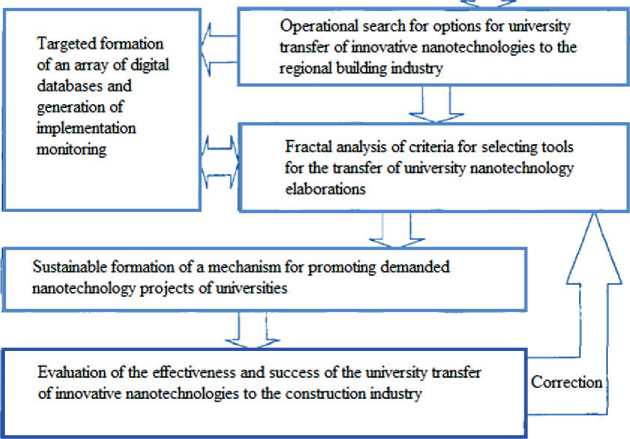
Fig. 4. Dynamics of various factors affecting the speed of introduction of nanotechnological elaborations of universities in the building industry
Quite effective methodological tools for the university transfer of nanotechnological elaborations to the regional construction industry are: the creation of basic departments in enterprises, the participation of employers in educational and industrial practice, the development of the university’s innovation ecosystem, etc. A thorough analysis of the impact of various factors on the speed of implementation and transfer of university innovations (Fig. 4) in the building complex based on the fractal concept shows the dynamic nature of commercialization algorithms.
The quality of innovative activities of universities in the form of commercialization and transfer mechanisms should not only be demanded and controlled, but also motivated. One of the final stages of a successful transfer of intellectual activity is the formation of internal protective mechanisms against unfair competition. Interdisciplinary integration with the features of large-scale introduction of nanotechnology products for construction purposes [19–23] promotes the transfer of the future technological and other activities in ment) is the focus on “regional linking” and the creation of research-educational centers.
The effective process of transfer and commercialization of popular nanotechnologies in modern universities cannot be considered in isolation from their main educa- tional activity. Educational activities in terms of content have a synthetic character: it is based on cognitive activity; students of the Architectural and Construction Institute of USPTU in the scientific and educational center form practical competencies. The implementation of innovative activities through the organization and development of the transfer of popular technologies to the real construction industry is an urgent task of domestic universities based on the results of pilot tests and industrial scaling. Nanomaterials (nanosilicon, carbon nanotubes diameter from 1 nm to 50 nm, ceramic nanocomposites, etc.) and microfillers were proved to be suitable components for reducing corrosion damage and increasing the durability of building composites [15–18].
the educational process and the formation of professional competencies of bachelors and masters of Architecture and Building Institute of Ufa State Petroleum Technological University.
CONCLUSION
Thus, the advance of methodological tools for monitoring the attractiveness of the regional business ecosystem for generation and development of transfer processes of modern nanomaterials is an integral element of designing mechanism for effective management of the development of business structures in building. Development of the innovation ecosystem in the university (construction institute, faculty, department) is the way to effective commercialization of intellectual activity in the field of nanotechnology, demanded by regional building industry: i.e., the process of transfer of knowledge and technology resulted in certain products and services.
APPLICATION OF NANOMATERIALS AND NANOTECHNOLOGIES IN CONSTRUCTION
Список литературы Methodological tools for university transfer of high-demand nanotechnologies to the regional building industry
- Ivanov L.A., Kapustin I.A., Borisova O.N. et al. Nanotechnologies: a review of inventions and utility models. Part II. Nanotechnologies in Construction. 2020;12(2):71–76. Available from: doi: 10.15828/2075-8545-2020-12-2-71-76.
- Pushkarenko A.B. Commercialization of scientific and technical developments as a constituent element of innovative activity of scientific and educational institutions. News of the Tomsk Polytechnic University. 2004;3:137-141.
- Antonets V.L., Nechaeva N.V., Khomkin K.A. et al. Innovative business: formation of models of commercialization of promising developments. Moscow: Delo Publishing House; 2009.
- Morgunov E.V., Zhavoronkov I.V. Development of the high-tech sector of the Russian economy. Bulletin of the University (SUМ). 2012;7:116–126.
- Solodilova N.Z., Malikov R.I., Grishin, K.E. Methodological tools to measure the state of regional entrepreneurial ecosystem. Economy of Region. 2018;14(4):1256–1269.
- Ugnich E.A., Izotov M.A., Voloshchenko I.I. Commercialization of the results of intellectual activity in universities: the concept of an innovative ecosystem. Internet-journal “Science of science”. 2015;7(4);48.
- Acs Z., Audretsch D., Lehmann E. et al. National systems of entrepreneurship. Small Business Economics. 2016;16(4):527–535.
- Doroshenko S., Shelomentsev A. Entrepreneurial ecosystem in modern socio-economic research. Journal of Economic Theory. 2017;4:212–221.
- Khalikov R.M., Sinitsina E.A., Silantyeva E.I. et al. Modifying intensification of the hardening of extruded construction gypsum nanocomposites. Nanotechnologies in Construction. 2019;11(5):549–560. Available from: doi: 10.15828/2075-8545-2019-11-5-549-560.
- Mirsaev R.N., Babkov V.V., Yunusova S.S. et al. Phosphogypsum waste of the chemical industry in the production of wall products. Moscow: Chemistry; 2004.
- Shayakhmetov U.Sh., Mustafin A.G., Nedoseko I.V. et al. Raw mixture for the production of gypsum binder and products based on it. Patent RU 2413688. 2011-03-10
- Gaitova A.R., Akhmadullina I.I., Pechenkina T.V. et al. Nanostructural aspects of hydration and hardening of gypsum and gypsum-slag compositions based on two-water gypsum. Construction Materials. 2014;1–2:46–51.
- Innovation Project Management. I.L. Tukell (ed.). St. Petersburg: BHV; 2011.
- Smirnova L.N, Rucińska T., Zvezdov A.I. Achievements of nanoindustry: projects, applications, economic effect and social significance. Nanotechnologies in Construction. 2020;12(1):41–45. Available from: doi: 10.15828/2075-8545-2020-12-1-41-45.
- Sinitsin D.A., Khalikov R.M., Bulatov B.G. et al. Technological approaches to directed structure formation of construction nanocomposites with increased corrosion resistance. Nanotechnologies in Construction. 2019;11(2):153–164. Available from: doi: 10.15828/2075-8545-2019-11-2-153-164. (In Russian).
- Sinitsina E.A., Nedoseko I.V., Khalikov R.M. et al. Application of filtration pressing technology in the production of roofing products. Construction materials. 2020;1–2:66–72. Available from: doi: 10.31659/0585-430X-2020-778-1-2-66-72.
- Gusev B.V., Kudryavtseva V.D., Potapova V.A. Concretes with nanoadditive of fired recycled concrete. Nanotechnologies in Construction. 2020;12(5):245–249. Available from: doi: 10.15828/2075-8545-2020-12-5-245-249.
- Diab A.M., Elyamany H.E., Abd Elmoaty M. et al. Effect of nanomaterials additives on performance of concrete resistance against magnesium sulfate and acids. Construction and Building Materials. 2019; 210: 210–231. Available from: doi: 10.1016/j.conbuildmat.2019.03.099.
- Shayakhmetov U.Sh., Fakhretdinov I.A., Khalikov R.M. et al. The process of formation of professional competencies of bachelor-material scientists in the field of heat-resistant nanostructured composites. Bulletin of the Bashkir University. 2014;19(1):248–252.
- Pashkevich A.V. Fundamentals of designing competence-oriented tasks as an effective way of evaluating metasubject results. Innovations in education. 2015;11:50–67.
- Bakunov V.S., Khalikov R.M., Shayakhmetov U.Sh. et al. Hardening of an alumophosphate composition during heating. Refractories and technical ceramics. 2016;3:24–27.
- Pisarenko Zh.V., Ivanov L.A., Wang Q. Nanotechnology in Construction: State of the Art and Future Trends. Nanotechnologies in Construction. 2020;12(4):223–231. Available from: doi: 10.15828/2075-8545-2020-12-4-223-231.
- Chernishov E.M., Artamonova O.V., Slavcheva G.S. Nanomodification of cement-based composites in the technological life cycle. Nanotechnologies in Construction. 2020;12(3):130–139. Available from: doi: 10.15828/2075-8545-2020-12-3-130-139.

